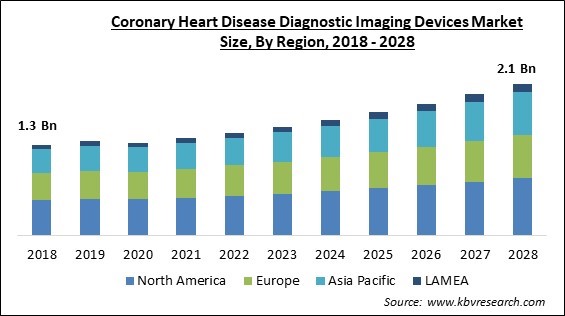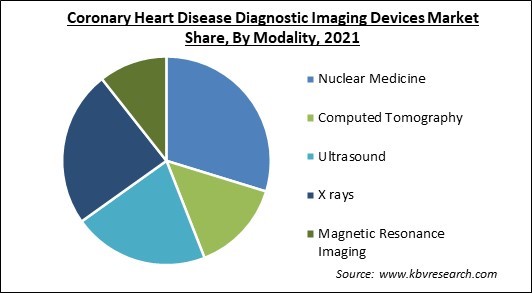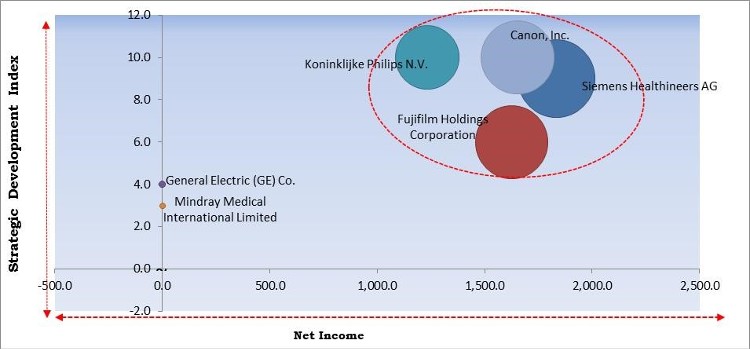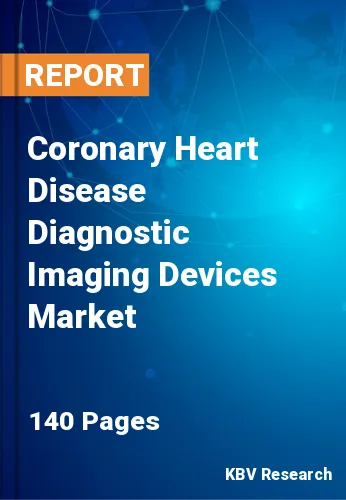The Global Coronary Heart Disease Diagnostic Imaging Devices Market size is expected to reach $2.1 billion by 2028, rising at a market growth of 6.7% CAGR during the forecast period.
Coronary Artery Disease, also called CAD, is a cardiovascular disease caused by diminished or missing blood flow in the arteries that encircle and supply the heart, also known as Ischemia. A dense layer of cholesterol, fat, and calcium develops a thick layer in the walls of arteries in a coronary artery, restricting blood flow.
Owing to a decrease in blood flow caused by coronary artery disease, the myocardial cell begins to die due to a lack of oxygen. Chest pain, heartburn, and soreness in the shoulder, arm, back, and neck are all symptoms of coronary artery disease. Coronary CT angiography, cardiac magnetic resonance imaging, and radionuclide modalities, such as single proton emission computed tomography (SPECT), positron emission tomography (PET), and PET/CT are the most common coronary artery imaging modalities. The image is enhanced with a variety of contrasting agents. CT pictures are commonly enhanced with iodine-based contrast agents, while MRI images are enhanced with gadolinium. In CT scans, radio-opaque iodine contrast dye is commonly administered through coronary arteries.
The most common symptoms of CAD are angina, chest pain, and discomfort. If too much volume increases inside arteries, they become narrow and cause angina. Blood flow to the heart muscle as well as the rest of the body might be blocked by narrowed arteries, which can cause chest pain. excess weight, inactivity, bad eating habits, and cigarette consumption are all risk factors for coronary artery disease. A family history of heart disease, particularly a family history of heart disease at an early age also raises the risk of CAD. Anyone healing from a heart failure, heart attack, or another heart disease that necessitated surgery or medical treatment may consider cardiac rehabilitation (rehab). Cardiac rehab can assist these people to improve their quality of life and prevent another heart attack.

Following the advent of the COVID-19 pandemic, CHD screening in hospitals, diagnostic centers, as well as ambulatory centers decreased. Any diagnostic or surgical actions in end-use settings were also halted due to concerns about virus transmission. This subsequently resulted in a financial crisis in hospitals, clinics, diagnostic centers, and other end-user settings, affecting newer installations. The diagnostic market was further affected by the suspension of diagnostic centers and a preference for solely diagnosing COVID-19-related tests. National closures, a halt in logistics, an economic downturn, a shift in focus to develop a treatment protocol, such as virtual care and tele-visits, and a shift in focus to establish a treatment protocol, like virtual care and tele-visits, all had an impact on new product launches and developmental activities.
The rise in cardiovascular disease incidence has enhanced the demand and expansion of cardiovascular ultrasonography. Cardiovascular imaging ultrasonography technologies, such as echocardiography and sonograms, are widely used to diagnose and monitor cardiovascular disorders like coronary artery disease, peripheral artery disease, congenital heart disease, atherosclerosis, and arrhythmia, among others. In the next years, the growth in incidence of cardiovascular illness is anticipated to stimulate the demand for cardiovascular ultrasound equipment.
Cardiovascular ultrasound technologies and display devices are widely utilized for a variety of purposes. By combining the system's performance with a powerful, software-based beamformer image reconstruction platform, a 2D cardiovascular ultrasound system can help to reduce non-diagnostic examination. Because of features like real-time imaging, accelerating procedural time and installing technology, advanced cardiac quantification, and improved clinical efficiencies, 3D and 4D cardiovascular ultrasound systems are widely used for echocardiographic imaging for treating and tracking cardiovascular and heart disorders.
Coronary heart disease diagnostic imaging devices are prohibitively expensive for low-budget healthcare organizations to purchase. This could pose a major challenge to the development of the coronary heart device diagnostic imaging device market. Moreover, poverty levels in various developing and underdeveloped countries have reached unacceptably high levels. People living in poverty and suffering from many types of cardiovascular ailments find it challenging to afford cardiovascular ultrasonography, limiting the prospects for the market players. Moreover, due to the integration of various advanced and latest technologies, the manufacturing cost of these devices also become higher, which is directly impacting the demand for these imaging devices in various low-income healthcare facilities.

Based on Modality, the market is segmented into Nuclear Medicine, Computed Tomography, Ultrasound, X rays, and Magnetic Resonance Imaging. In 2021, the Nuclear Medicine segment procured the highest revenue share of the market. Non-invasiveness, image clarity, precise illness identification even at an early stage, and rising adoption among end-users are the factors attributed to the rising growth of this segment. Unlike any other modality, a huge number of radiologists are properly trained to use the nuclear medicine instrument and read the image precisely.
| Report Attribute | Details |
|---|---|
| Market size value in 2021 | USD 1.4 Billion |
| Market size forecast in 2028 | USD 2.1 Billion |
| Base Year | 2021 |
| Historical Period | 2018 to 2020 |
| Forecast Period | 2022 to 2028 |
| Revenue Growth Rate | CAGR of 6.7% from 2022 to 2028 |
| Number of Pages | 140 |
| Number of Tables | 192 |
| Report coverage | Market Trends, Revenue Estimation and Forecast, Segmentation Analysis, Regional and Country Breakdown, Competitive Landscape, Companies Strategic Developments, Company Profiling |
| Segments covered | Modality, Region |
| Country scope | US, Canada, Mexico, Germany, UK, France, Russia, Spain, Italy, China, Japan, India, South Korea, Singapore, Malaysia, Brazil, Argentina, UAE, Saudi Arabia, South Africa, Nigeria |
| Growth Drivers |
|
| Restraints |
|
Based on Regions, the market is segmented into North America, Europe, Asia Pacific, and Latin America, Middle East & Africa. In 2021, North America accounted for the largest revenue share of the coronary heart disease imaging device market. The growth of the regional market is increasing due to several factors, such as the presence of technically advanced medical staff, improved government healthcare expenditure, an increase in the number of cancer cases, and an increase in the obesity ratio in contrast to other nations, as well as increased research and development activities.
Free Valuable Insights: Global Coronary Heart Disease Diagnostic Imaging Devices Market size to reach USD 2.1 Billion by 2028

The major strategies followed by the market participants are Product Launches. Based on the Analysis presented in the Cardinal matrix; Koninklijke Philips N.V., Siemens Healthineers AG , Fujifilm Holdings Corporation , Canon, Inc. are the forerunners in the Coronary Heart Disease Diagnostic Imaging Devices Market. Companies such as General Electric (GE) Co. and Mindray Medical International Limited are some of the key innovators in theMarket.
The market research report covers the analysis of key stake holders of the market. Key companies profiled in the report include General Electric (GE) Co. (GE Healthcare), Koninklijke Philips N.V., Siemens Healthineers AG, Fujifilm Holdings Corporation, Canon, Inc. (Canon Medical Systems Corporation), Mindray Medical International Limited, Chison Medical Technologies Co., Ltd., and Analogic Corporation (Altaris Capital Partners).
By Modality
By Geography
The global coronary heart disease diagnostic imaging devices market size is expected to reach $2.1 billion by 2028.
Rising incidences of cardiac diseases are driving the market in coming years, however, high cost of the product growth of the market.
General Electric (GE) Co. (GE Healthcare), Koninklijke Philips N.V., Siemens Healthineers AG, Fujifilm Holdings Corporation, Canon, Inc. (Canon Medical Systems Corporation), Mindray Medical International Limited, Chison Medical Technologies Co., Ltd., and Analogic Corporation (Altaris Capital Partners).
The expected CAGR of the coronary heart disease diagnostic imaging devices market is 6.7% from 2022 to 2028.
The North America market dominated the Global Coronary Heart Disease Diagnostic Imaging Devices Market by Region in 2021, and would continue to be a dominant market till 2028.
Our team of dedicated experts can provide you with attractive expansion opportunities for your business.

